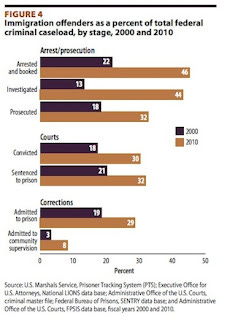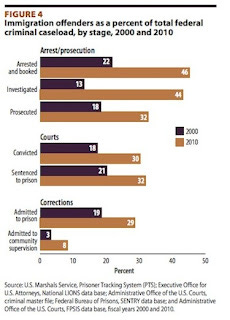Private prisons profits on the rise as immigration arrests continue to grow.
For three years in a row, more people have been convicted of immigration offenses than of any other type of federal crime, according to the United States Sentencing Commission. Illegal re-entry into the United States was the most commonly filed federal charge last year, marking a dramatic shift in the makeup of the U.S. criminal justice system, which has been dominated by drug crimes in recent decades.

As a surge of new immigration offenders flow into the federal prison system, they are being held primarily in private prisons operated by multibillion-dollar corporations that contract with the government. Federal prison officials argue that privatization saves money and frees up space for more violent criminals in government-run prisons.
But critics contend that the expanding web of privatized prisons for undocumented immigrants is substandard, where prisoner uprisings have become common due to poor conditions and inadequate medical care.
"These are basically second-class prisoners," said Judith Greene, the director of Justice Strategies, who has researched the rise of private prisons over nearly three decades and recently wrote a report on federal prisons for undocumented immigrants. "They're hiring cheap labor, and they're not putting dollars into the things that keep prisoners relatively content: medical care and food."
Congress is on the verge of appropriating more than $25 million for another 1,000 contracted private prison beds to hold more undocumented immigrant offenders, and the offer from the federal Bureau of Prisons contains a 90 percent occupancy guarantee. Nearly 100 civil and human rights groups wrote a letter this month urging prominent members of the Senate and House appropriations committees to vote against additional expansion.
"We call upon you to redirect funding from the wasteful prosecution and incarceration of low-level immigration violations and focus resources instead on correctional programs that will better prepare federal prisoners for constructive lives when they are released," read the letter.
A series of academic reports, including studies performed by Federal Bureau of Prisons researchers, have found minimal cost savings at private prisons. Other reports have found that conditions inside private federal prisons are comparatively worse than in government-run facilities, with more overall prisoner misconduct occurring inside private prisons.
Beginning in 1999, the Federal Bureau of Prisons began looking to the private sector to run facilities housing so-called criminal aliens, or non-citizens serving time for federal crimes.
Over the years, the Bureau of Prisons has provided a steady source of revenue to private prison companies. Corrections Corporation of America took in $205 million from Bureau of Prisons contracts at the end of 2011, up from $132 million at the end of 2002, according to company financial statements. The GEO Group took in $258 million from federal prison contracts at the end of 2011, up from $64 million at the end of 2004, according to securities filings.
The average sentence for illegal re-entry is between one and two years, though those convicted of the crime can be held up to 10 years if the offender has a criminal history in the U.S., according to a recent report from Grassroots Leadership, a criminal justice advocacy group.
For private prisons, according to the group's report, "The threat of a 100 percent criminal referral rate at the border presents an enormous opportunity to expand."
Federal immigration arrests have doubled since 2005, and the number of criminal immigration suspects referred to U.S. attorneys' offices has jumped from fewer than 40,000 in 2006 to more than 84,000 in 2010, according to a Bureau of Justice Statistics report released this summer.

http://www.huffingtonpost.com/2012/09/27/private-prisons-immigration_n_1917636.html
Realigning justice resources: A review of population and spending shifts in prison and community corrections.
http://www.vera.org/files/Full%20Report.pdf


